History of Egyptian Art History - Egyptian art history
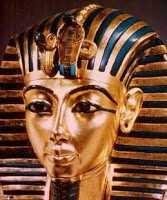
History of Egyptian Art History / Egyptian art history
The development of foreign pure art outside Asia originated from ancient Eastern art to the history of modern European art. Ancient Eastern art can be seen through the development of art in Egypt. The development period can be described chronologically, starting from the history of Egyptian art, classical European art, Renaissance art, Barok and Rokoko art, to modern art.
Egypt is a nation that has the oldest cultural heritage in the world (since 3400 BC). Forms of works of art of the Egyptians in the form of building art, sculpture, relief, painting, and art craft. The building art of Egypt consists of pyramidal buildings, mastaba, and temples. Pyramid and mastaba is a building that serves to store mummies, while the temple serves as a place of worship. Egyptian sculpture is made of granite stone which is a depiction
from Ramses, Chefren, Achnaton, Amenhotep, and Spinx. Egyptian reliefs and paintings are found on walls of graves and coffins. Other relics in the form of craft objects, such as pottery, jewelry, and crown
The period of ancient Egyptian rule was in the form of dynastic formation, a theocracy in which the rulers (pharaohs), as rulers, thinkers and also raised themselves as gods. This power began in the Nile Valley around 3150 BC, and lasted up to 31 dynasties. The dynasty ended after Egypt fell to the Roman Empire in about the 30th century BC. In the period of Roman rule gradually there was a change of politics and religion and it was this period that ended the development of Egyptian independent civilization.
Ancient Egyptian civilization was located in the northeastern part of Africa centered throughout the mid to lower Nile River and reached its glory around the 2nd century BC, called the New Kingdom period. Its territory includes the Nile Delta in the north, to Jebel Barkal in Cataract. In some times, Egyptian civilization extends to the south of the Levant, the Eastern Desert, the shores of the Red Sea, Semenajung Sinai, and the Western Desert.
Ancient Egyptian form of civilization among other forms of building (Architecture), writing, sculpture, relief, painting, mummies etc., high and still survive.
Some examples of works / relics of art at that time I can share here that I mostly collected from encarta microsoft 2005 as well as several other sources.
# ***Building / Architecture**
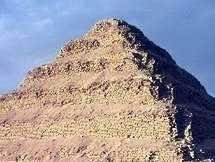
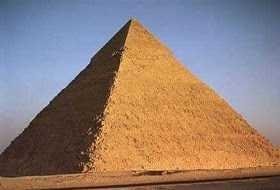
Step Pyramid, KingZoser at Sakarah, Egyptian pharaoh from 2630 to 2611 B.C. (Microsoft® Encarta®, 2005)

The bent pyramid, built during the reign of King Sneferu (2575 BC-2551 BC). Initially the architect built a wall with a 55 degree angle, Then they encountered structural problems until continued to 43 degrees level. (Microsoft® Encarta®, 2005).

4000 years of age, the Sphinx (the statue of a lion's man), the great Giza is a well-known badge of ancient Egypt. (Microsoft® Encarta®, 2005).
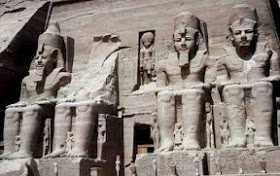 The temple of Abu Simbel, around 1250 BC was built by Pharaoh of Egypt Ramesses II, in southern Egypt. In front of the entrance-out of the temple stood masiv four statues of King Ramses II who was sitting.
The temple of Abu Simbel, around 1250 BC was built by Pharaoh of Egypt Ramesses II, in southern Egypt. In front of the entrance-out of the temple stood masiv four statues of King Ramses II who was sitting.

Temple of Queen Hatshepsut, Egyptian Ruler of 1400s BC. Its Funerary Temple is near the Valley of the Kings, in Luxor. (Microsoft® Encarta®, 2005).
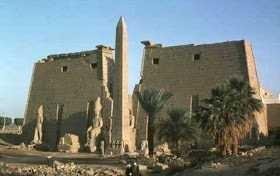
The Temple of Luxor, located east of the Nile, dates back to about 1200 BC to honor the gods. Temple buildings were added upward by each dynasty. In front there is a monument (obelist) and a colossal statue. The temple is connected to Al Karnak Temple by a 3.5 km long road. Along the way is decorated with hundreds of sphinxes. In once a year the god Amon was transported by a barge from Al Karnak to Luxor, at a major festival.

Al Karnak Temple, Approx. 1,500 BC. Many temples are built in Al Karnak, the most important being made by Thutmose III, which ruled Egypt 1400s BC. The Hieroglyphs writing on the temple wall tells the story of Thutmose's military prowess in extending the Egyptian kingdom to Asia and Africa

Hypostyleum, Amon Temple in Karnak, supported by 100 pillars, each of which is 20 m high. Built by Ramses II in 1200 BC.
# STATUS / SCULPTURE 
The Luxor Statue in Thebes Temple, Thebe is the capital of Egypt's past, is the site of Luxor Temple. (Microsoft® Encarta®, 2005)

The statue of King Khafre sits, from 2500 BC, carved from a solid stone block diorite, the hard rock of the old kingdom of the Kingdom in Egypt. Height of 165 cm (66) tall and is an idealized representation of kings, with strong geometric shapes and dramatic proportions. (Microsoft® Encarta®, 2005).
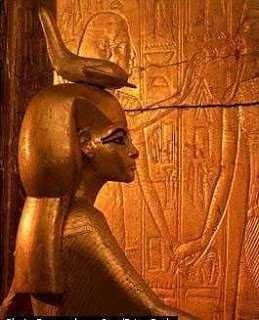
The statue of Dewi Selket, which was discovered the tomb of King Tutankhamun of Egypt. the goddess who heals biting and sting, is portrayed as a beautiful woman with a scorpion on her head. Gold strands are made by forging solid gold that is very thin metal.

This bronze cat goddess depicts blue-glass looking at the seeds of Egypt's End-End Period (712-332 BC). It shows the bark of the ancient goddess tree in the form of a cat.